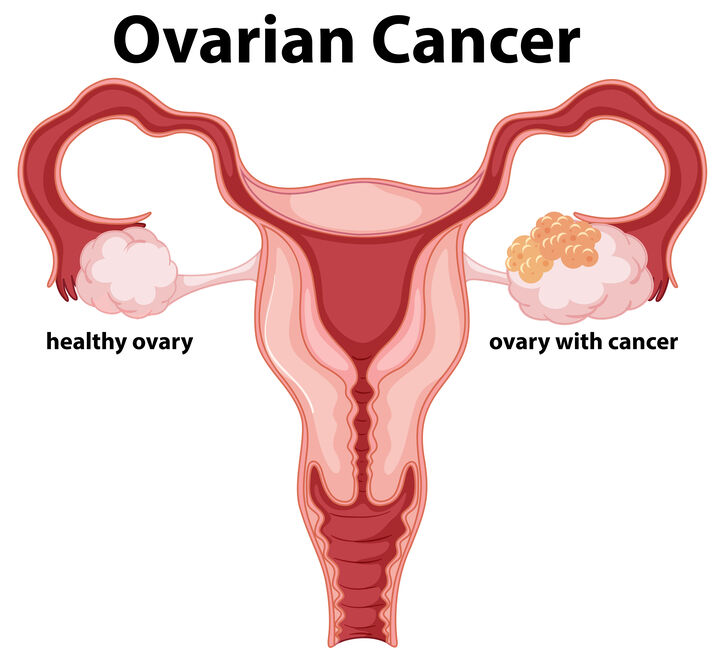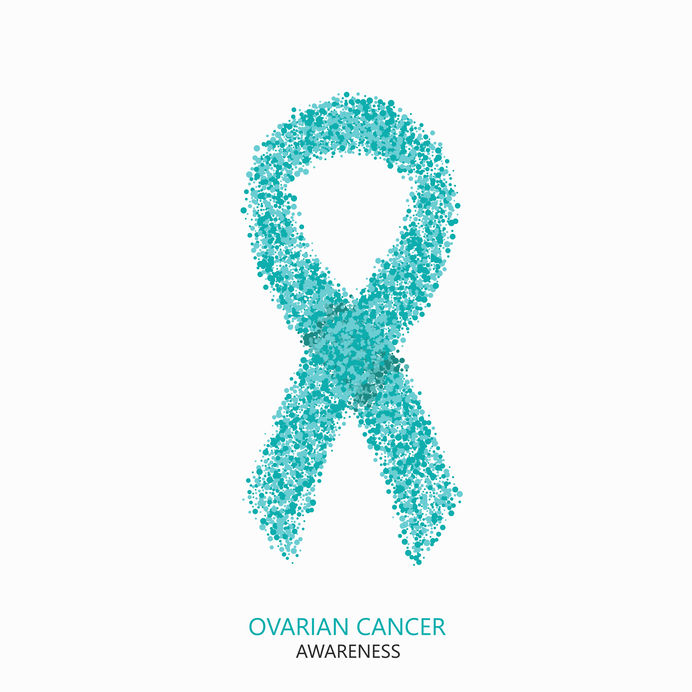September is National Ovarian Cancer month. This year, nearly 20,000 women in the United States will be diagnosed with ovarian cancer. Hard to detect and frequently discovered in advanced stages, this disease is often deadly for so many.
What is Ovarian Cancer?
Cancer is a disease in which abnormal cells in the body grow out of control. Cancer is usually named for the body part where it starts, even if it spreads to other body parts later. Ovarian cancer is when malignant (cancerous) cells develop in or near the outer layer of one or both ovaries.

Types of Ovarian Cancer
There are many types of ovarian cancer. Normally, healthy cells in your body divide and form new cells to repair injuries and replace old or dying cells. Cancer cells are different because they:
- Grow uncontrollably, dividing into new abnormal cells
- Outlive normal cells
- Lead to the growth of a tumor; this can put pressure on nearby organs
- Can spread or metastasize to other parts of the body through the bloodstream or lymphatic system
The type of cancer is determined by the site where it started. So, when cancer cells are first formed in the ovaries and spread to other organs, they will be diagnosed and treated as ovarian cancer.
Cancerous ovarian tumors start from three common cell types:
- Surface epithelium are cells covering the outer lining of the ovaries
- Germ cells are cells that will form eggs
- Stromal cells release hormones and connect the different structures of the ovaries
What Are the Signs and Symptoms?
The signs and symptoms of ovarian cancer can be easy to miss. They may be difficult to notice or detect because the ovaries are deep within the abdominal cavity. They can also be mistaken for other health issues. Often, the signs and symptoms are subtle, making ovarian cancer difficult to detect in its early stages. This is why only about 20% of cases are diagnosed early (stages I-II). Often symptoms don’t appear until the disease is in its advanced stages (stages III-IV).
Common Symptoms
- Bloating-you may notice swelling in the lower pelvis or abdomen, and clothes around the waist may feel tighter than normal
- Pelvic or abdominal pain-pain in the abdomen, back, or pelvis
- Trouble eating/feeling full quickly-feeling full after eating only a few bites or loss of appetite
- Urinary frequency-feeling the need to urinate more frequently

Less Common Symptoms
- Pain during sex-discomfort or pain during sex
- Back pain-pain or discomfort in the lower back
- Fatigue-feeling more tired than usual and more often
- Menstrual changes-changes to your monthly menstrual cycle, including additional bleeding or vaginal discharge
- Upset stomach, heartburn, or constipation-this may include diarrhea or changes in bowel habits such as urgency or pain
How is Ovarian Cancer Diagnosed?
The earlier ovarian cancer is found and treated, the better a woman’s chance for survival. There is no effective screening test for ovarian cancer. A Pap smear test does not detect ovarian cancer but screens for cervical cancer.
Although no consistently reliable screening test exists to detect ovarian cancer, research in this area is ongoing. If a woman has signs and symptoms of ovarian cancer, the following tests are available and should be offered, especially to those at increased risk:
- Pelvic Exam: This checks for an enlarged ovary or signs of fluid in the abdomen. The doctor examines the uterus, vagina, ovaries, bladder, and rectum for unusual changes such as a mass. Some cancers are very small before they spread and cannot be reliably detected by pelvic examination.
- Transvaginal Ultrasound: This examination uses a small instrument placed in the vagina to examine the ovaries and uterus. This method is appropriate for women at increased risk for ovarian cancer or those with an abnormal pelvic exam.
- CA-125 Blood Test: This measures the level of CA-125, a protein found in higher levels in women with ovarian/fallopian tube cancer. While CA-125 is an important test, it is not always a key marker for the disease. Some non-cancerous diseases of the ovaries can also increase CA-125 levels, and some ovarian cancers may not produce enough CA-125 levels to cause a positive test.
Treatment Options
As science progresses, ovarian cancer treatment options expand and therapies advance. If ovarian cancer is diagnosed, your oncologist will discuss the best course of treatment. This usually involves surgery, chemotherapy, targeted therapy, and in rare cases, radiation therapy. Surgery is the main form of treatment for ovarian cancer. The surgery depends on your general health and how far cancer has spread, which may not be known until it is performed.

The two main goals of ovarian cancer surgery are to stage the cancer and remove as much as possible so there is no visual evidence of disease. This is known as debulking surgery.
It’s possible to treat some ovarian cancers without removing the uterus and ovaries. These are important considerations for women of childbearing age to discuss, so it is important to have surgery performed by a gynecologic oncologist – a specialist in cancers of the female reproductive organs.
If you are having signs and symptoms of ovarian cancer, reach out to your health care provider as soon as possible!
At South Avenue Women’s Services, we encourage women to take control of their health and reproductive systems. You are in charge of your body and your decisions.
For women in need of gynecology exams, we offer a safe environment with trained and knowledgeable staff.
Contact us at (585)271-3850 to learn more about our services and to schedule an appointment!

